brake VOLKSWAGEN GOLF 2009 Owners Manual
[x] Cancel search | Manufacturer: VOLKSWAGEN, Model Year: 2009, Model line: GOLF, Model: VOLKSWAGEN GOLF 2009Pages: 516, PDF Size: 105.12 MB
Page 107 of 516
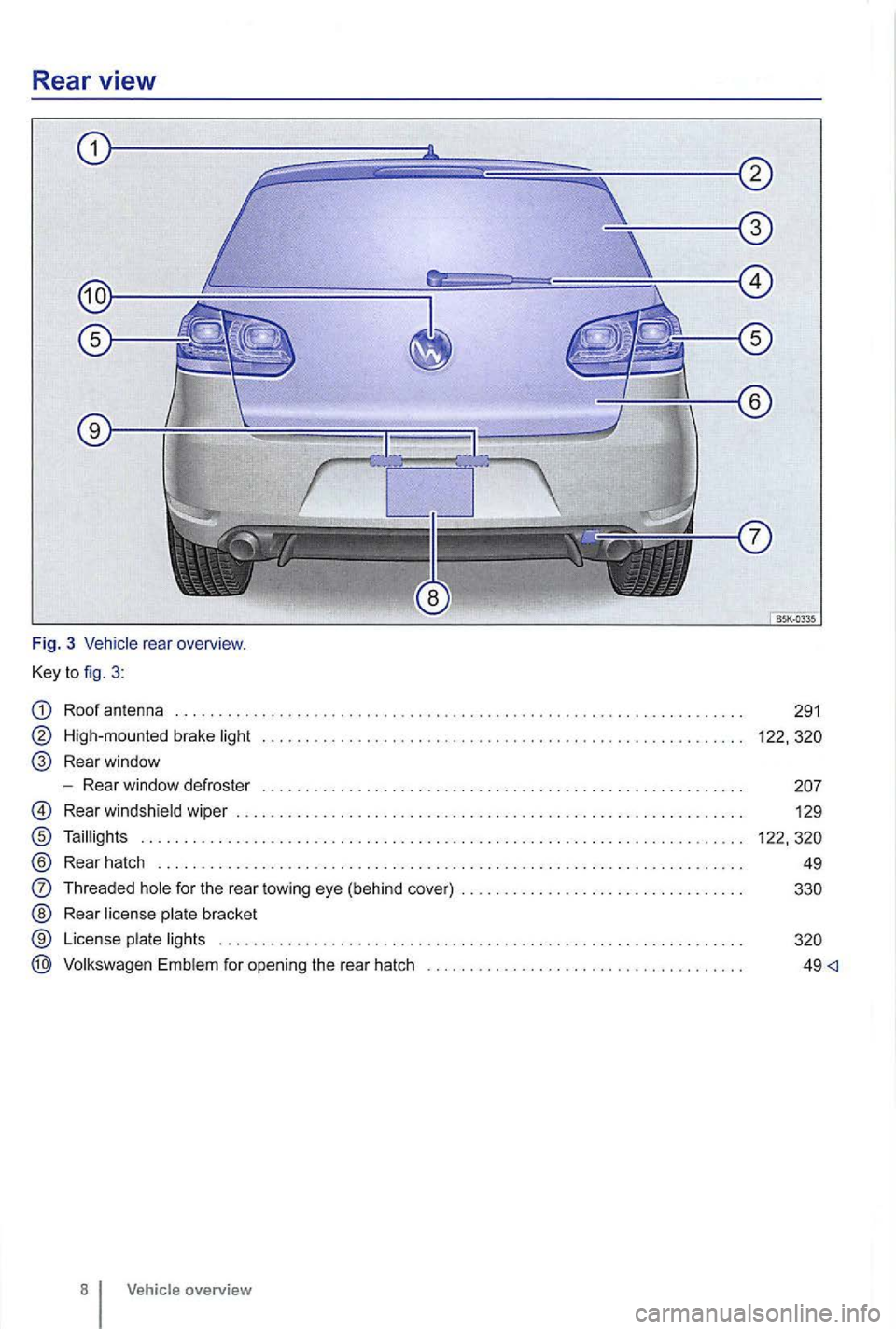
Rear view
Fig. 3 rear overview .
Key
to fig . 3 :
Roof antenna
High-mo unted brake light
Rear window
- Rear window defroste r
Rear windsh ield wiper ..... . .
Taillig hts
® Rear hatch ............... .
Threaded hole for the rea r towing eye (behind cov er) . ...
Rear license plate bracket
License plate li gh ts
E mb lem for open ing the rear hatch
8 Vehicle overview
291
122,
49 <]
Page 114 of 516
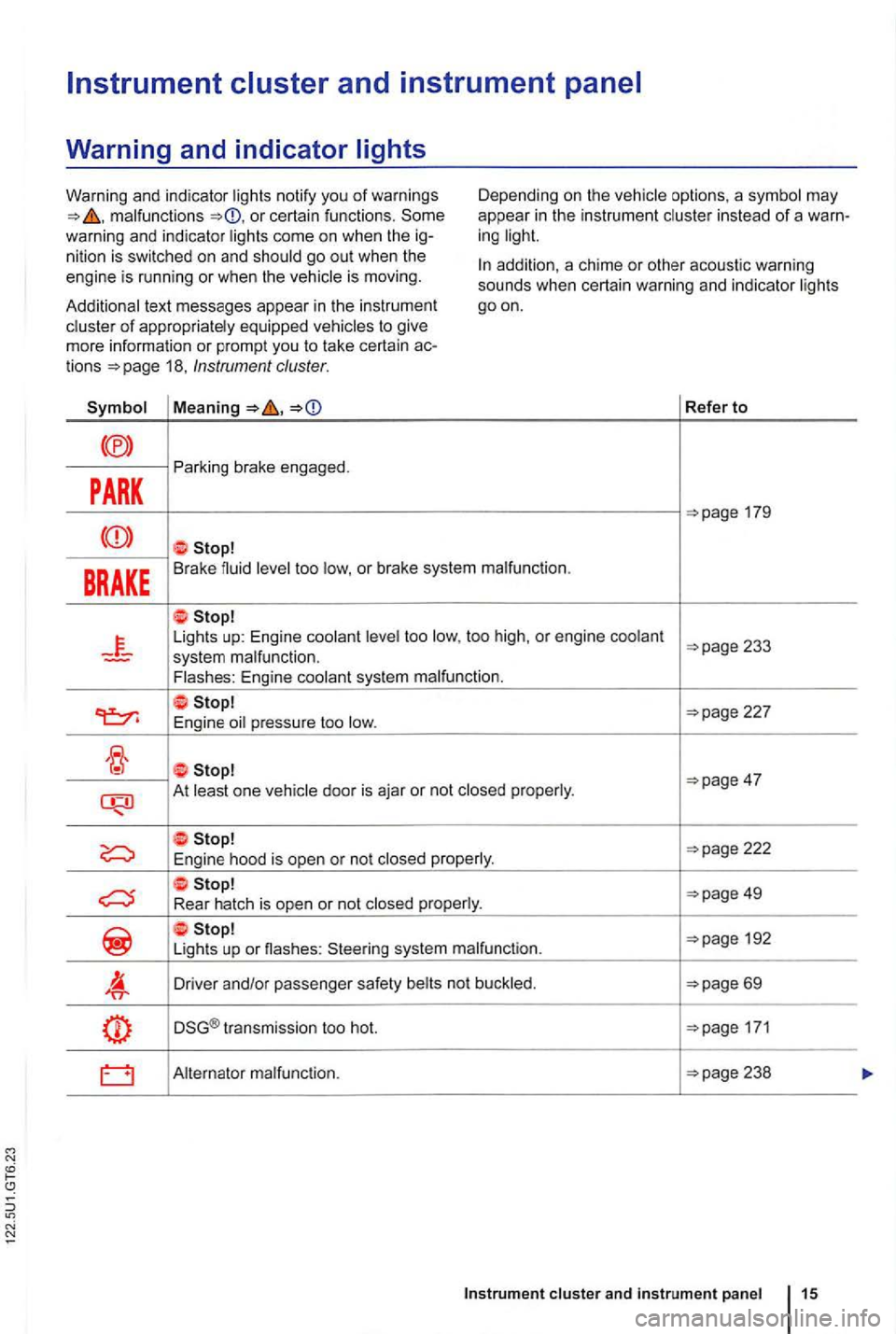
malfunctions or certain functions . Some
warning and indicator ligh ts come on when the ig
nition is swi tched on and shou ld go out when the
engine is running or when the vehicle is moving. D
epending on the vehicle options, a symbol may
appea r
in the instrum en t cluster in stead of a warn
ing light.
Additional text messages appear in th e instrumen t
cluster
of appropriately equipped vehicles to give
mo re information or prompt you to take certain actions 18, Instrument cluster.
addition, a chime or other acoustic warning
sounds when certain warning and indicator lights
goon.
Refer to
PARK
Parking brake engaged.
BRAKE Brake fluid level too low, o r brake system malfunction .
Lights up: Engine coolant level too low, too high , or engine coolant
227
E ngine oil pressure too low.
At least one vehicle door is aja r or not closed properly .
192
Li gh ts up or nashes : Steering system malfunction.
Driver and/or passenger safety belts not buckled .
DSG® transmission too hot. 171
Alternator malfunction.
cluster and instrument panel 15
Page 115 of 516

Refer to
BRAKE
WEAR Front brake pads worn.
Lights up: switched off. or is working.
deactivated.
. 122
Lights up or flashes : Engine monitoring system Light-
Lights up or flashes: with the steering . 192
Tire pressure is too or Tire Pressure Monitoring function.
Not enough 129
tank
cap not
Lights up: engine too 227 -system malfunction .
Airbag and safety
Passenger front airbag turned off BAG
Turn
299
overview
Page 132 of 516

N
on page 31.
Note the
Check th e depth of the water before driving
thr ough it. The wate r must not be any higher than the bottom of th e body
Do not dr ive faster tha n wa lking speed.
Never stop th e vehicle, and do not drive in verse or switch the engi ne off when driving through
water.
Oncoming vehicles may create waves that
raise the water
After driving through water, mud, etc., the brakes react
water.
Some basics 33
Page 224 of 516
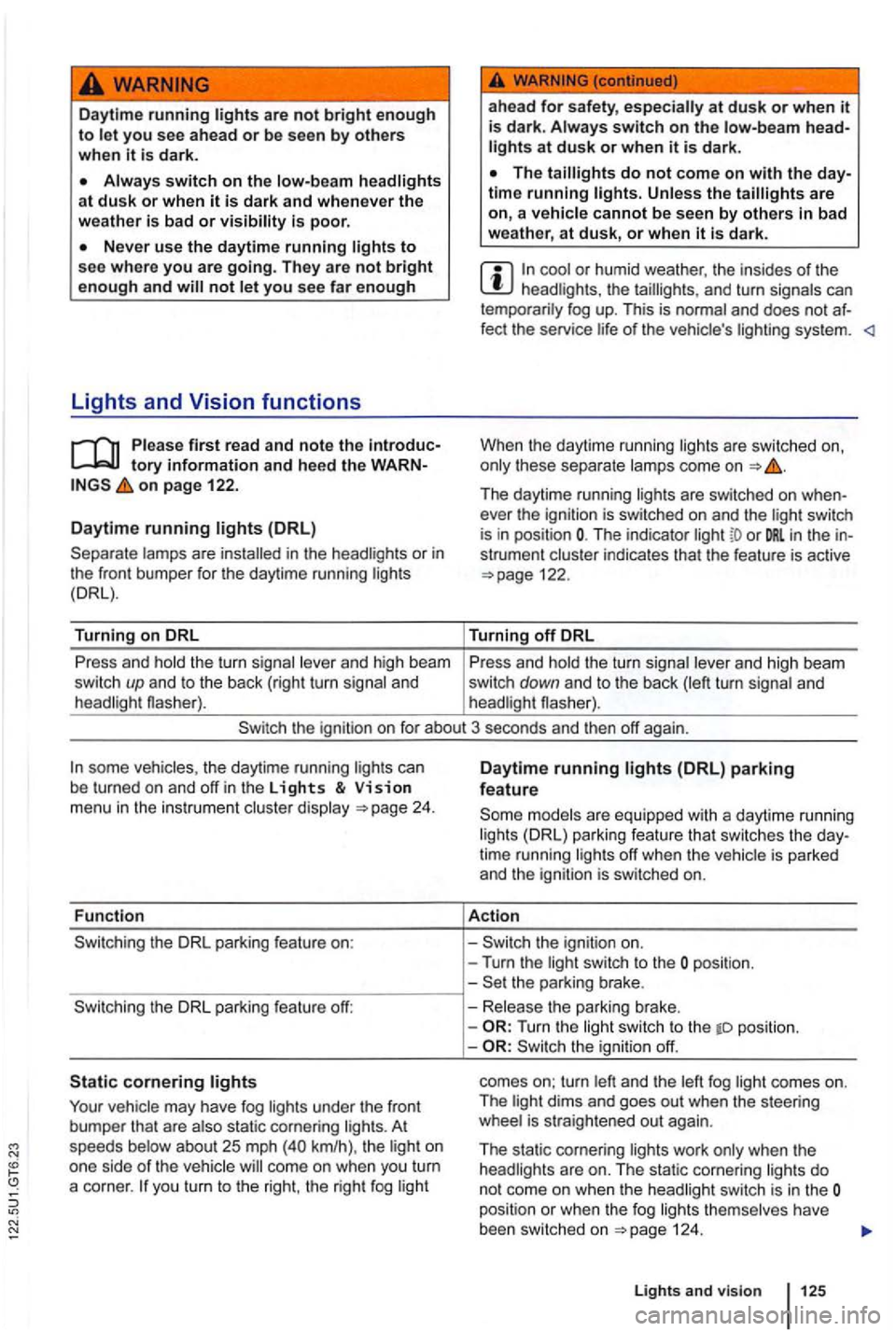
are not bright enough to le t you see ahead or be see n by others when it is dark.
not let you see far enough
Lights and
tory information and the WARNon page 122.
Daytime running
lamps are or in the front bumper fo r t he daytime running lights
( DRL ).
Turning on DRL
ahead for safety,
at dusk or when it i s dark .
are on, a vehicle cannot be seen by others
cool or humid weathe r, th e insides of the
lighting system.
When the dayt ime running are switched on,
only these separa te lamps com e on =>
Th e daytime running lights are switched on when
ever the ign itio n is swi tched on and the ligh t sw itch is in position The indicator or in th e instrument cluster indicates that the feature is active =>page 122.
Turning
off DRL
P ress and ho
ld the turn signa l leve r and high beam Press and hold the turn signa l lever and high beam
switc h up and to the back (right turn sign al and switch down and to the back (left turn signa l and
headlight flasher). headlight flasher).
the ignit ion on f or about 3 seconds and then off again .
th e ignition on.
- Turn the ligh t swi tch to the posi tion.
the parki ng brake.
vehicl e may have fog lights under the front
bumpe r that are also static corneri ng l ight s. A t
speeds below about 25 mp h km/h ), th e l igh t on
one side of t he
yo u turn to the right , the righ t fog light -
Release the parking brake.
-
Turn the light swit ch to the tD pos ition.
-the igni tio n off.
comes on; turn left and the left fog l
ight comes on .
T he light dims and goes out when the steering
whee l is st
raig ht ened out again.
T he static cornering lights work only when the
are on. The static corneri ng lights do not come on when the switch is in the position or when the fog lights themselves have
been switched on =>page 124.
Light s and vision
Page 237 of 516

Never exceed the Gross Axle Weight ing or the Gross
Always adapt your speed and driving to
the heavier load and the weight distribution in the vehicle . Take road, weather , traffic, and visibility conditions into account as
Please first read and note the tory information and heed the on page 137.
Always stow luggage securely in the
Distribute the load in the vehicle, on the roo f,
and in the trailer as evenly as possible .
Put heavy objec ts as far forward as possib le in
the luggage compartmen t and securely latc h t he
rear seat backrest in the upright position .
luggage in the luggage compartmen t to
the tie-downs with su itable straps
Adjust the headlig ht range 122 .
Check the pressure in 4 tires when the tires
are
P ay especially close att enti on to your vehicle 's Tire Pressu re M on itoring
Driving with an open rear hatch
tory information and heed the on page 137.
D rivi ng with
an ope n rear hatch can lead to se riou s
personal injury. if you have to drive with an ope n
rear hatc h, make sure t hat objec ts and the
hatch it sel f are properly secured and take
Before d riving
den braking and driving maneuvers .
Always brake earlier than you would if you were not driving a loaded vehicle. <1
The defroster heating wires or antenna in the rear window can be damag ed by objects that rub against them.
Please review the in forma tion on loadi ng a tr ai le r 149 and a roof rack 146. <1
Driving with a n unlatched or open rear hatch
ca n lead to serious personal injury.
After clo sing the rear hatch, always
Page 238 of 516
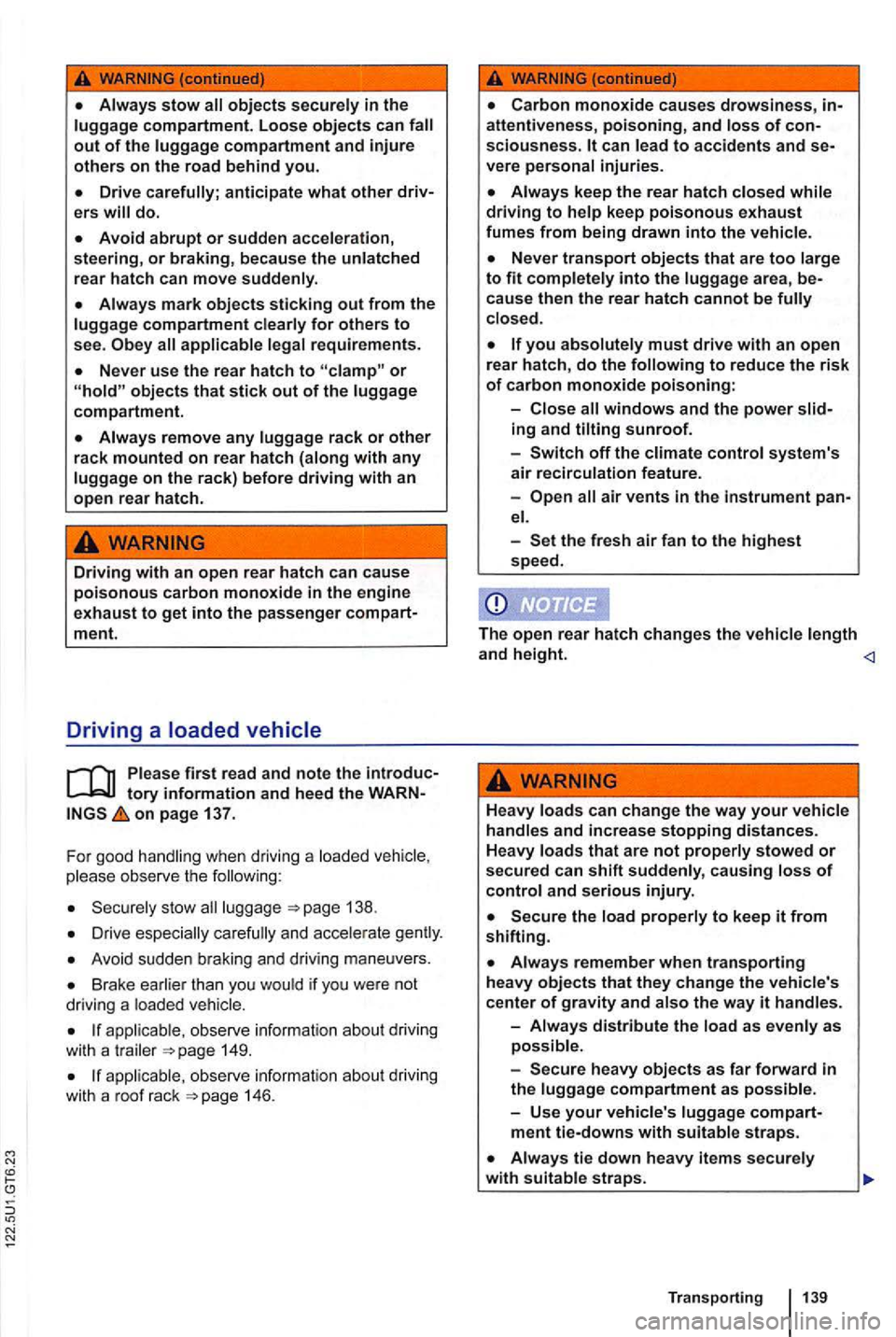
stow in the compartment. Loose objects can compartment and injure others on the road behind you.
ers
compartment for others to see. requirements.
Never use the rear hatch to or objects that stick out of the compartment.
rack or othe r
rack mounted on rear hatch
Driving with an open rear hatch can cause poisonous carbon monoxide in the engine exhaust to get into the passenger ment.
Driving a
first read and note the tory information and heed the on page 137.
For good
observe the
stow 138 .
Driv e gently.
Avoid sudden braking and driving maneuvers.
Brake if you were not
driving a
observe information abo ut driving with a 149.
1 46 .
attentiveness, poisoning, and of sciousness. can vere
driving to keep poisonous exhaust fumes from being drawn into the
to fit into the area,
you must drive with an open rear hatch, do the to reduce the risk of carbon monoxide poisoning:
-
the fresh air fan to the highest
speed.
The
open rear hatch changes the and height.
Heavy can change the way your and increase stopping distances. Heavy stowed or secured can shift suddenly, causing of and se riou s injury.
to keep it from shifting.
remember when transporting heavy objects that they change the vehicle's center of gravity and the way it
-as
heavy objects as far forward in the
tie down heavy items
Tran sporting 139
Page 239 of 516
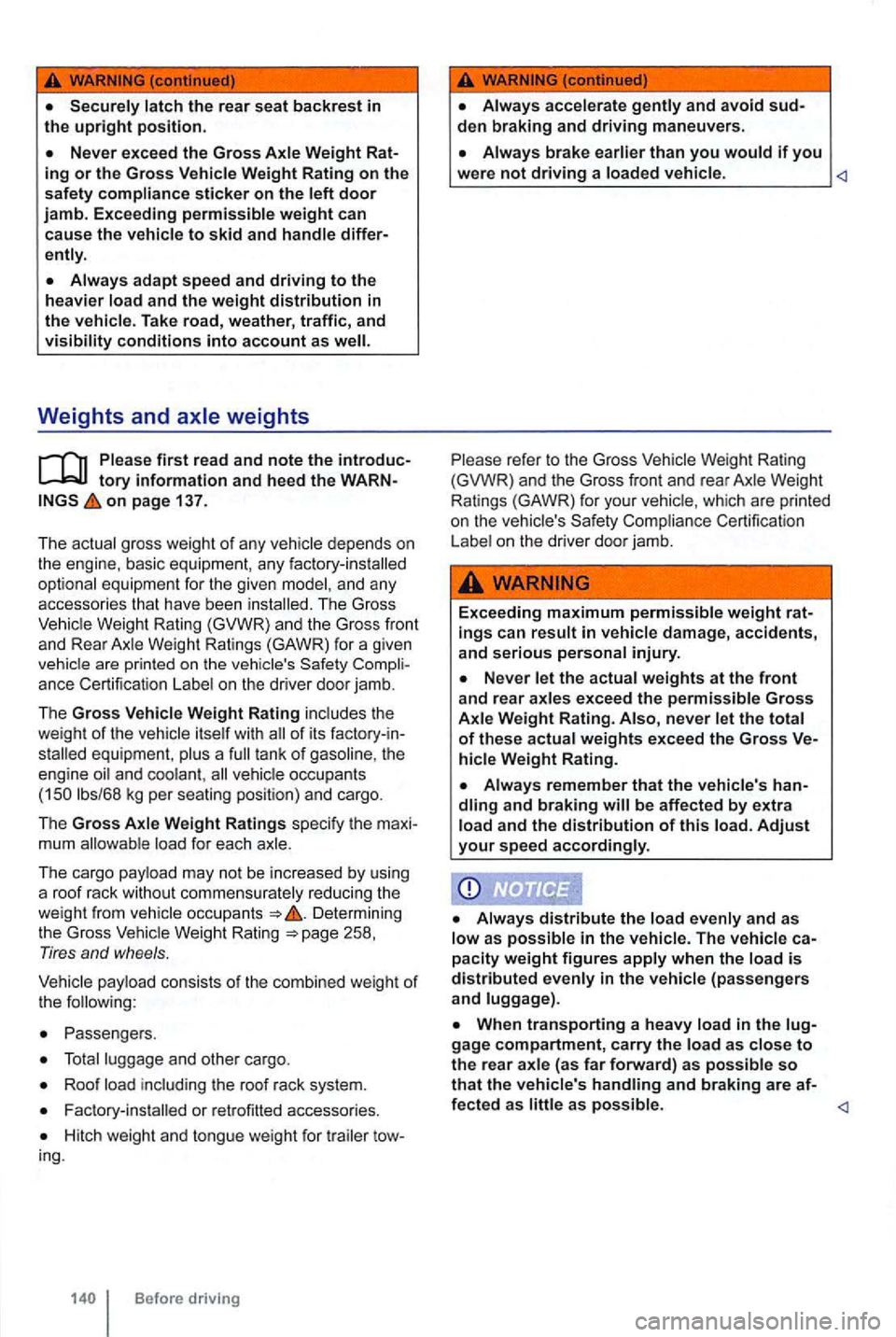
the rear seat backrest in the upright position.
Weight Rating on the
safety sticker on the door j amb. Exceeding
ad apt speed and driving to the heavier and the weight distribution in the Tak e road , weather , traffic, and
Weights and axle weights
first read and note the
on page 137 .
T he
gross weight of any depends on
the eng ine. basic equipme nt, an y fac tory-installed equipment for the given and any
ac cessories tha t have been The Gross Weigh t Rat ing (GVWR) an d t he G ross front
a nd Rea r
are p rinted on th e S afety on the driver door ja mb.
The Gross the
weight of the a t ank of the
e ngine and
Weight R atings specify th e
may not be increased by using
a roo f rac k withou t commens urate ly red ucing th e
weig ht fr o m D ete rmi ning the Gross
Passe ngers.
Roo f
Factory-insta lled or re trofitted accesso ries.
H itch weight and tongue weight for
and avoid den braking and driving maneuver s.
brake than you
(GVWR) and the Gross fr ont and rear
which are printed
on the Certification on the driver door jamb .
damage, accidents,
and seriou s
Never the exceed the Gross Weight Rating. never the weights exceed the Gross Weight Rating .
remember that the and braking be affected by extra Adjust your s p ee d
distribute the as in the The
in the (passengers and
When transporting a heavy in the ga ge compartment, c arry the as to the rear so that the and braking are af-
f ec ted as
Page 249 of 516
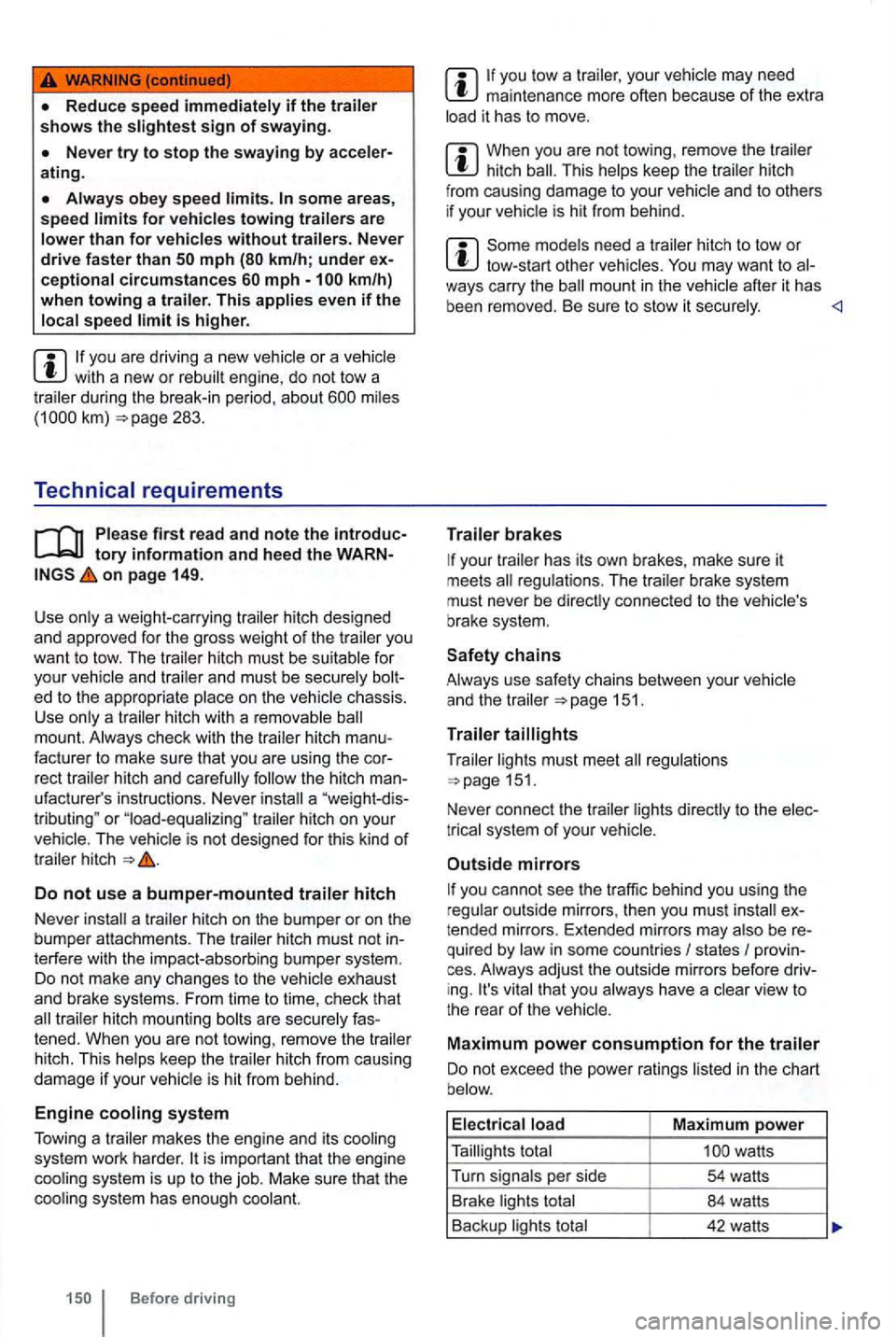
some area s, speed
is higher.
you are driv ing a new vehicle or a ve hicle with a new or rebui lt engine, do not tow a during the break-in period, about 283.
Technical requirements
tory informatio n an d heed the WARNon page 149.
Use only a weight-car rying
hitch must be suitable for
you r
a "weight -dis
tributing " or "load-equalizing " trailer hitch on your The vehicle is not designed for this kind of trailer hitch
Do not use a bumper-mounted traile r hitch
Never
a trailer hitch on the bumper or on the
bumper attachments. The trailer hitch must not in
terfe re with the impact-absorbing bumper system.
Do not make any changes to the vehicle exhaust
and brake systems. From time to time, check that trailer hitch mounting bolts are secure ly fas
tened. When you are not towing, remove the trailer
hitch. This
helps keep the trailer hitch from causing damage if your vehicle is hit from behind.
Engine cooling syste m
Tow i
ng a trailer makes the engine and its cooling
system work harder.
Before driving
maintenance more often because of the extra
load it has to move.
When you are not towing , remove the trailer hitch
Some models need a trailer hitch to tow or tow-start other vehicles. after it has
been removed. Be sure to stow it securely.
your trailer has its own brakes , make sure it
meets
151 .
T ra
iler
Trailer lights must meet regulations 151.
Never connect the trailer lights directly to the elec
t rical system
of your
Outside mirrors
you cannot see the traffic behind you using the
r egular outside mirrors, then you must ex
t ended mirrors. Extended mirrors may also be re
quired by law in some countries
I states I provin
ces . Always adjust the outside mirrors befo re dr iving. It's vital that you always have a clear view to
the rear of the veh icle .
Maximum po w er con sumption fo r the trailer
Do not exceed the power ratings listed in the chart
b elow.
E l
ectr ica l load Maximum power
Taillights total
Page 252 of 516
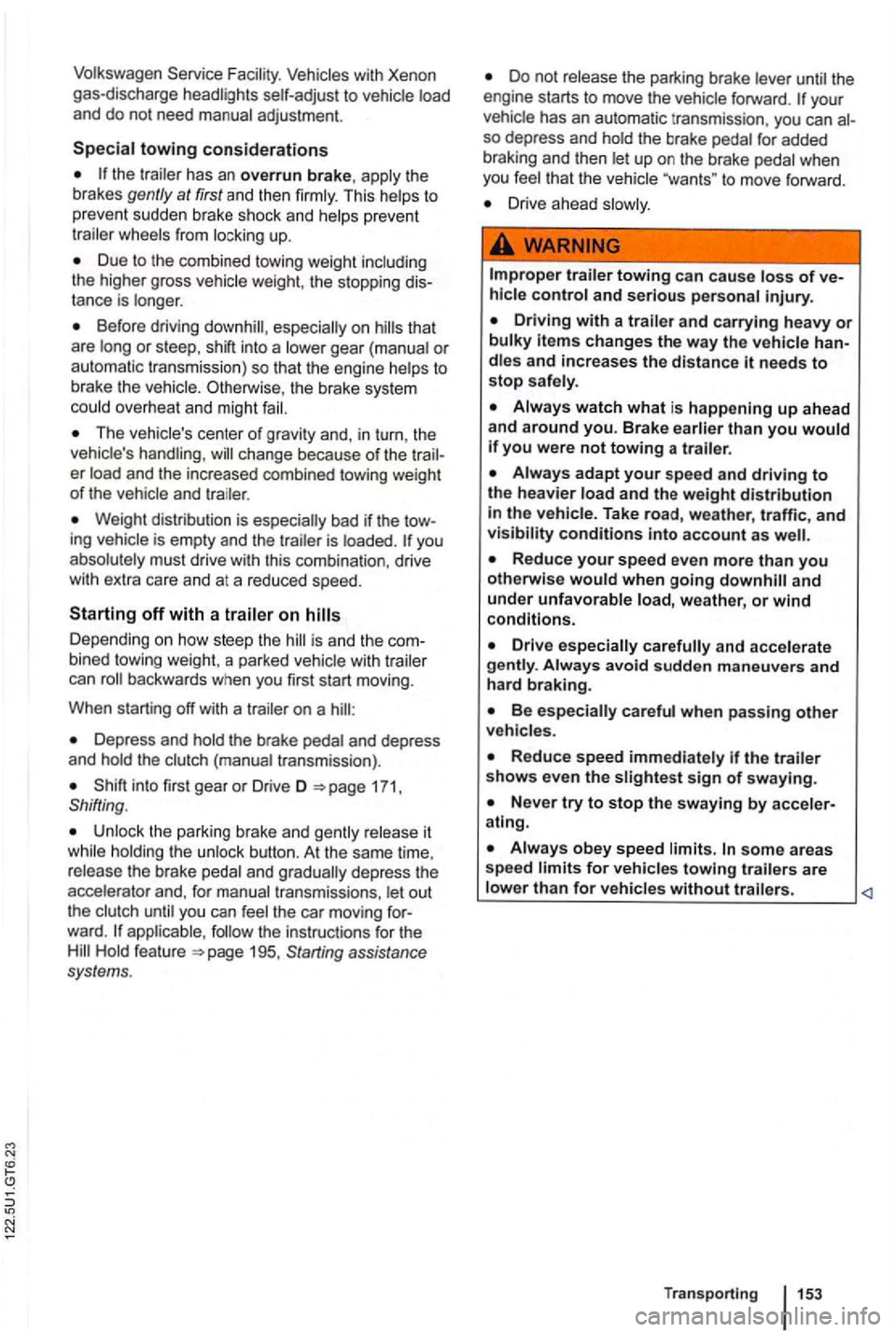
Volkswagen Service Vehicles with Xenon
gas-discharge self-adjust to vehicle load
and do not need manual adjustment.
Special towing considerations
th e t railer has an overrun brake, apply the
br akes
Due to the combined towing weight including
the higher gross vehicle weight, the stopping
tance is longer.
Be fo re drivi ng especially on
The vehicle's center of grav ity and , in turn, the
Weight distribution is especially bad if the is emp ty and the trailer is loaded.
Depending on how steep the is an d the
backwards when you first start moving.
When starting off with a tra iler on a
Depress and hold the brake pedal and depress
and hold the clutch (manu al transmission).
171, Shifting .
Unlock the parking brake a nd gently release it
whi le holding the unlock button. At the same time,
release the brake pedal and
depress the
accelerator and, for manual transmissions , let out
the clutch
you can feel the car moving ward . applicable, follow the instruct ions for the Hold feat ure
Do not release the parking brake lever until the
engine starts to move the vehicle forward. your
vehicle has an automatic tr ansmission , you can
so depress and hold the brake peda l for added
b raking and then Jet up on the brake pedal when
you feel that the to move forward .
Drive ahead slowly.
hicle contro l and serious per sonal injury.
dles and increases the distance it needs to stop safely .
Always adapt your sp ee d and driving to th e heavier loa d and the weight distribution in the vehicle. Tak e road , weather , traffic, and visibility conditions into account as well .
Always avoid sudde n maneuv ers and ha rd braking.
atin g.
som e areas
s p ee d for vehicles towing trailers are
lower than for vehicles without trailers.